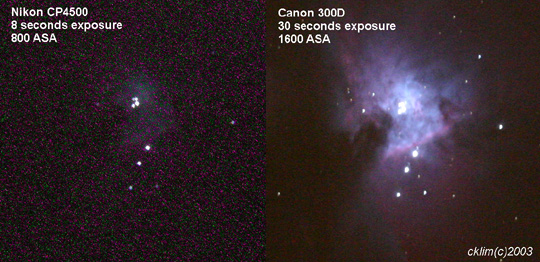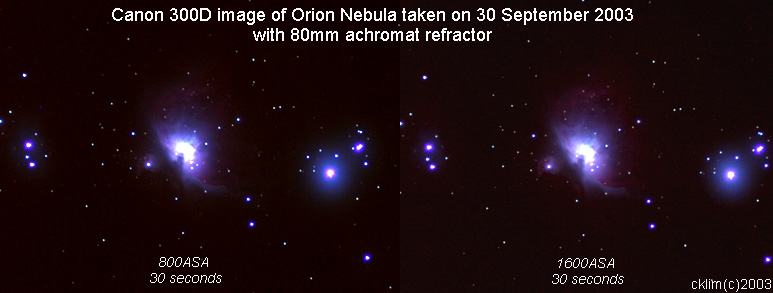
Canon 300D
I bought this camera on the 27th September 2003, barely 10 days after it was released. The price? RM3700. It may be a little bit more than most people would like to spend on a camera but for a digital SLR, it is cheap! A couple of years back, this camera would cost RM10K.
So, why did I choose this camera? Here are the reasons.
1) DSLR - meaning you can change lens. You can also remove the lens and have the camera connected directly to the telescope. It is also digital, meaning no need to use film.
2) Uses CMOS as a detector - most camera uses CCD as the detector, but this camera uses CMOS which operate at very low power, hence less noise.
3) Up to 1600ASA possible - the higher the number, meaning the detector is more sensitive, resulting in more stars you can image. Of course, you can get more noise too but they can be reduced through image processing.
4) Unlimited exposure time - as with the normal SLR you can set the camera to bulb mode and exposure as long as you want (this is only partly true. For this camera, you can put the camera on bulb mode continuously for 2.5 hours before the battery ran out)
5) Large 6.3M pixels sensor - cover more skies with a given focal length.
TEST 1 (Nikon CP4500 vs Canon 300D)
After less than a week use, I was pretty much impressed with what this camera can do. The noise is much lower that I had expected. Since I don't have a cable release yet, I can only do a 30 seconds exposure. I have use up to 1600ASA with 30 seconds exposure. But so far, I was continue to be amazed by the low noise level.
Here is the comparison between my Nikon CP4500 camera and Canon 300D.

Of course, this is no an apple to an apple comparison. But you can see that even at higher ASA rating and longer exposure, the image taken with Canon has far less noise than Nikon.
Here is the full image of M42/M43 taken on 1st October 2003 from my backyard.
Although this is only a 30 seconds exposure, I was able to image stars of 14th magnitude. Furthermore, when the above image was taken, the condition was bad with clouds passing over the object.
TEST 2 (800ASA vs 1600ASA)

I don't see any signification improvement over the image taken with 1600ASA setting.
For a 30 seconds exposure I have also taken a wide field image of the crab nebula. Due to some light pollution, I couldn't see the nebula at all. I have converted this image to look like a star chart. Next time, if I have any problem locating some objects, I will try this method. No problem seeing a 13th magnitude stars.
I will take more images with the Canon 300D and post the result here.